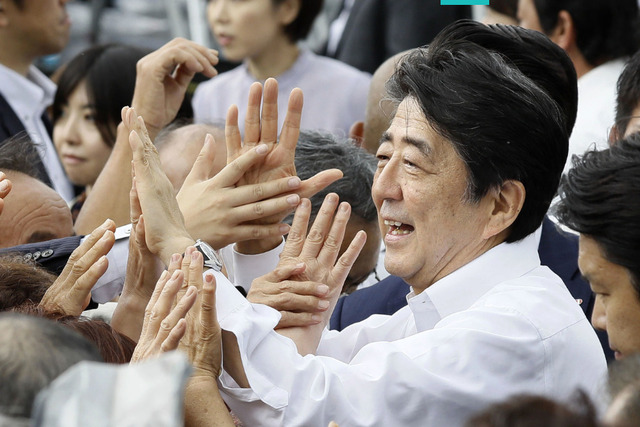Posted on : Jul.8,2019 16:53 KST
Modified on : Jul.8,2019 17:39 KST
 |
|
Japanese Prime Minister Shinzo Abe at a campaign rally in Fukushima on July 4.
|
The South Korean government is moving swiftly to devise countermeasures against Japan’s retaliatory trade measures. Over the weekend on July 7, Minister of Economy and Finance and Deputy Prime Minister Hong Nam-ki and Blue House Policy Chief of Staff Kim Sang-jo met with the leaders of several South Korean chaebol, including Hyundai Motor, SK, and LG, to discuss ways to counter Japan’s export controls. A roundtable discussion between South Korean President Moon Jae-in and the leaders of the country’s 30 largest companies is also scheduled to be held soon. We hope that the joint response by the government and private sector will mitigate the shock of Japan’s measures and that this will turn out to be an opportunity to fundamentally reduce South Korea’s dependence on Japan and to rectify structural imbalance in our economy.
During a television debate on Sunday, the fourth day since the retaliatory trade measures took effect, Japanese Prime Minister Shinzo Abe said that since South Korea is not keeping its agreements with other countries — referring to its claims agreement with Japan — it’s only natural to suspect that it won’t properly abide by rules regulating trade. The allegation that Abe was raising is that the South Korean government might not thoroughly implement sanctions against North Korea. Abe may have been warning that more retaliation is to come.
Japan’s trade retaliation gives us a chance to keenly feel the vulnerability of the South Korean economy, given its heavy dependence upon Japan. It’s painful to recall that, since South Korea and Japan normalized their diplomatic relations in 1965, South Korea has never once enjoyed a trade surplus with Japan, and that its cumulative trade deficit amounts to US$604.6 billion. In the first half of this year alone, the deficit stood at US$9.9 billion. The deficit was particularly severe in the area of parts and materials, which accounted for US$6.7 billion, or two-thirds of the total. Though the share of intermediate goods in the manufacturing industry that are produced in Japan has decreased considerably in recent years, from 25.5% in the first quarter of 2010 to 15.9% in the first quarter of this year, South Korea unfortunately still depends on Japan for critical components.
We mustn’t stop with short-term measures such as holding behind-the-scene negotiations between diplomats, filing a complaint with the World Trade Organization (WTO), fighting to win over public opinion around the world, and having financial authorities review the flow of Japanese funding. To the contrary, this conflict illustrates the need for devising mid- and long-term measures to fundamentally compensate for the weaknesses of the South Korean economy.
The South Korean Ministry of Trade, Industry, and Energy is currently devising countermeasures for Japan’s export controls, which it plans to announce shortly. It’s also planning to add funding for programs that can promote parts and material development within the year to the supplementary budget bill. While fostering domestic production of parts and materials and diversifying our sources of imports is easier said than done, this is an urgent task for companies to steadily pursue with the proactive support of the government. We have no choice but to take action on the assumption that export controls or other retaliatory measures could be imposed at any time. Provided that the government and the corporate sector take joint action, this trade dispute could be a wake-up call for further increasing the competitiveness of South Korean industry and overhauling vulnerable aspects of our economy.
Please direct comments or questions to [english@hani.co.kr]






